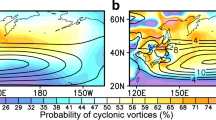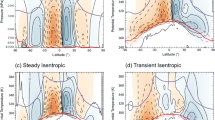Abstract
Climatological properties, dynamical and thermodynamical characteristics of the Catalina Eddy are examined from the 61 years NCEP/NCAR Reanalysis downscaled to hourly 10 km resolution. The eddy is identified as a mesoscale cyclonic circulation confined to the Southern California Bight. Pattern correlation of wind direction against the canonical Catalina Eddy is used to extract cases from the downscaled analysis. Validation against published cases and various observations confirmed that the downscaled analysis accurately reproduces Catalina Eddy events. A composite analysis of the initiation phase of the eddy indicates that no apparent large-scale cyclonic/anti-cyclonic large-scale forcing is associated with the eddy formation or decay. The source of the vorticity is located at the coast of the Santa Barbara Channel. It is generated by the convergence of the wind system crossing over the San Rafael Mountains and the large-scale northwesterly flow associated with the subtropical high. This vorticity is advected towards the southeast by the northwesterly flow, which contributes to the formation of the streak of positive vorticity. At 6 hours prior to the mature stage, there is an explosive generation of positive vorticity along the coast, coincident with the phase change of the sea breeze circulation (wind turning from onshore to offshore), resulting in the convergence all along the California coast. The generation of vorticity due to convergence along the coast together with the advection of vorticity from the north resulted in the formation of southerly flow along the coast, forming the Catalina Eddy. The importance of diurnal variation and the lack of large-scale forcing are new findings, which are in sharp contrast to prior studies. These differences are due to the inclusion of many short-lived eddy events detected in our study which have not been included in other studies.
Similar content being viewed by others
References
Bosart, L., 1983: Analysis of a California Catalina eddy event. Mon. Wea. Rev., 111, 1619–1633.
Carson, T. N. 1998: Mid-latitude weather system. Amer. Meteor. Soc., 707 pp.
Clark, J., 1994: The role of kelvin waves in evolution of the Catalina Eddy. Mon. Wea. Rev., 122, 838–850.
_____, and S. Dembek, 1991: The Catalina eddy event of July 1987: A coastally trapped mesoscale response to synoptic forcing. Mon. Wea. Rev., 119, 1714–1735.
Davis, C., S. Low-Nam, and C. Mass, 2000: Dynamics of a Catalina eddy revealed by numerical simulation. Mon. Wea. Rev., 128(8), 2885–2904.
Dormán, C., 1985: Evidence of kelvin waves in California’s marine layer and related eddy generation. Mon. Wea. Rev., 113, 827–839.
Eddington, L. W., J. J. O’brien, and D. W. Stuart, 1992: Numerical simulation of topographically forced mesoscale variability in a wellmixed marine layer. Mon. Wea. Rev., 120, 2881–2896.
Juang, H. -M. H., and M. Kanamitsu, 1994: The NMC nested regional spectral model. Mon. Wea. Rev., 122, 3–26.
Kanamaru, H., and M. Kanamitsu, 2007: Fifty-seven-year California Reanalysis Downscaling at 10 km (CaRD10). Part II: Comparison with North American regional reanalysis. J. Climate, 20(22), 5572–5592.
Kanamitsu, M., and H. Kanamaru, 2007: Fifty-seven-year California Reanalysis Downscaling at 10 km (CaRD10). Part I: System detail and validation with observations. J. Climate, 20(22), 5553–5571.
_____, K. Yoshimura, Y.-B. Yhang, and S.-Y. Hong, 2010: Errors of interannual variability and trend in dynamical downscaling of reanalysis. J. Geophys. Res., 115, D17115.
Kessler, R., and S. Douglas, 1991: A numerical study of mesoscale eddy development over the santa barbara channel. J. Appl. Meteorol., 30, 633–651.
Mass, C. F. and M. D. Albright, 1989: Origin of the catalina eddy. Mon. Wea. Rev., 117, 2406–2436.
_____, and W. J. Steenburgh, 2000: An observational and numerical study of an orographically trapped wind reversal along the west coast of the United States. Mon. Wea. Rev., 128(7), 2363.
Mesinger, F., and Coauthors, 2010: North American regional reanalysis. Bull. Amer. Meteor. Soc., 87, 343–360.
Reason, C. J. C. and D. G. Steyn, 1992: The dynamics of coastally trapped mesoscale ridges in the lower atmosphere. J. Atmos. Sci., 49, 1677–1692.
Skamarock, W. C., R. Rotunno, and J. B. Klemp, 2002: Catalina eddies and coastally trapped disturbances. J. Atmos. Sci., 59(14), 2270–2278.
Small, I. J., 1999: An observational study of a california bight coastal convergence zone produced by flow interaction with mainland topography: Precipitation producer in Southern California. Western Region Technical Attachment, (No. 99-19). Retrieved from http://www.wrh.noaa.gov/wrh/99TAs/9919/index.html.
Thompson, W. T., S. D. Burk, and J. Rosenthal, 1997: An investigation of the catalina eddy. Mon. Wea. Rev., 125(6), 1135.
Ueyoshi, K., and J. Roads, 1993: Simulation and prediction of the Catalina eddy. Mon. Wea. Rev., 121, 2975–3000.
Ulrickson, B. L., J. S. Hoffmaster, J. Robinson and D. Vimont, 1995: A numerical modeling study of the catalina eddy. Mon. Wea. Rev., 123, 1364–1373.
Wakimoto, R., 1987: The catalina eddy and its effect on pollution over southern california. Mon. Wea. Rev., 115, 837–855.
Willett, C. S., R. R. Leben, and M. F. Lavin, 2006: Eddies and tropical instability waves in the eastern tropical pacific: A review. Prog. Oceanogr., 69(2–4), 218–238.
Author information
Authors and Affiliations
Corresponding author
Rights and permissions
About this article
Cite this article
Kanamitsu, M., Yulaeva, E., Li, H. et al. Catalina Eddy as revealed by the historical downscaling of reanalysis. Asia-Pacific J Atmos Sci 49, 467–481 (2013). https://doi.org/10.1007/s13143-013-0042-x
Received:
Revised:
Accepted:
Published:
Issue Date:
DOI: https://doi.org/10.1007/s13143-013-0042-x




